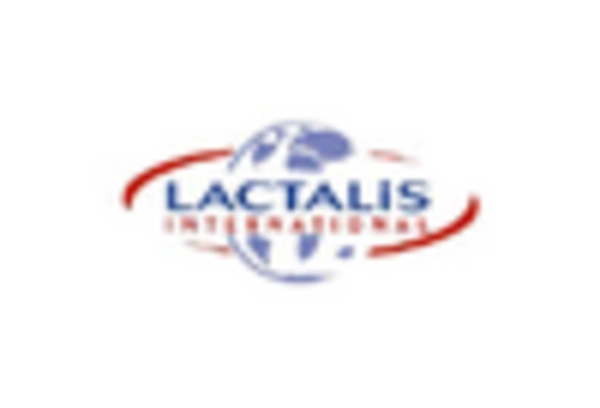Increasing Demand for Organic Dairy Products
The dairy market in Europe is experiencing a notable shift towards organic dairy products. Consumers are increasingly prioritizing health and wellness, leading to a surge in demand for organic milk, cheese, and yogurt. In 2025, organic dairy sales are projected to account for approximately 10% of the total dairy market, reflecting a growing preference for products perceived as healthier and more environmentally friendly. This trend is driven by heightened awareness of food sourcing and production methods, as well as a desire for products free from synthetic additives. As a result, dairy producers are adapting their offerings to meet this demand, potentially enhancing their market share and profitability in the organic segment.
Regulatory Changes Impacting Dairy Production
Regulatory frameworks are increasingly influencing the dairy market in Europe. Stricter regulations regarding animal welfare, environmental sustainability, and food safety are shaping production practices. For example, the European Union's Common Agricultural Policy (CAP) has introduced measures aimed at promoting sustainable farming practices, which could impact dairy producers' operational costs and practices. Compliance with these regulations may require investments in sustainable technologies and practices, potentially affecting profit margins. However, adherence to these regulations can also enhance brand reputation and consumer trust, which are vital in the competitive dairy market.
Technological Advancements in Dairy Production
Technological innovations are playing a crucial role in shaping the dairy market in Europe. The adoption of advanced technologies such as automation, precision farming, and data analytics is enhancing productivity and efficiency in dairy farming. For instance, the implementation of robotic milking systems has been shown to increase milk yield by up to 15%, while reducing labor costs. Furthermore, these technologies enable better herd management and health monitoring, which can lead to improved milk quality. As dairy producers invest in these advancements, they are likely to gain a competitive edge, positioning themselves favorably within the evolving dairy market landscape.
Evolving Consumer Preferences for Dairy Alternatives
The dairy market in Europe is witnessing a transformation as consumer preferences evolve towards dairy alternatives. This shift is largely influenced by dietary trends, including lactose intolerance and veganism, prompting a rise in the consumption of plant-based milk and cheese. In 2025, the market for dairy alternatives is expected to grow by approximately 20%, indicating a significant shift in consumer behavior. This trend presents both challenges and opportunities for traditional dairy producers, who may need to innovate and diversify their product lines to retain market relevance. The increasing availability and variety of dairy alternatives could reshape the competitive dynamics within the dairy market.
Rising Export Opportunities for European Dairy Products
The dairy market in Europe is benefiting from expanding export opportunities. European dairy products, known for their quality and safety standards, are increasingly sought after in international markets. In 2025, exports of European dairy products are projected to reach €10 billion, driven by demand from regions such as Asia and the Middle East. This trend is bolstered by trade agreements that facilitate access to new markets, allowing European dairy producers to diversify their revenue streams. As a result, the ability to tap into these export markets may provide a significant growth avenue for the dairy market, enhancing overall industry performance.


















Leave a Comment